Have you ever gone out the door for an important meeting wearing your best black suit, only to realize an hour later that you have grey fuzz clinging to you all over? Sometimes a fine dusting of lint on your clothes seems impossible to avoid. The good news is that you can learn how to remove lint from clothes in several easy steps with products you probably already have on hand!
The best way to remove lint from clothes is to use a lint roller, a handful of masking tape, or a dryer sheet to wipe the fuzz off the fabric. To remove lint in the washer, add white vinegar to the machine or use an air fluff setting on the dryer to help prevent lint from clinging to clothing. Commercial products like an antistatic spray can help prevent lint accumulation as well.
In this article, you will find out why lint sticks to clothes. You will learn twelve methods for removing lint quickly. Finally, you will discover several handy tips for how to prevent lint buildup in the first place.
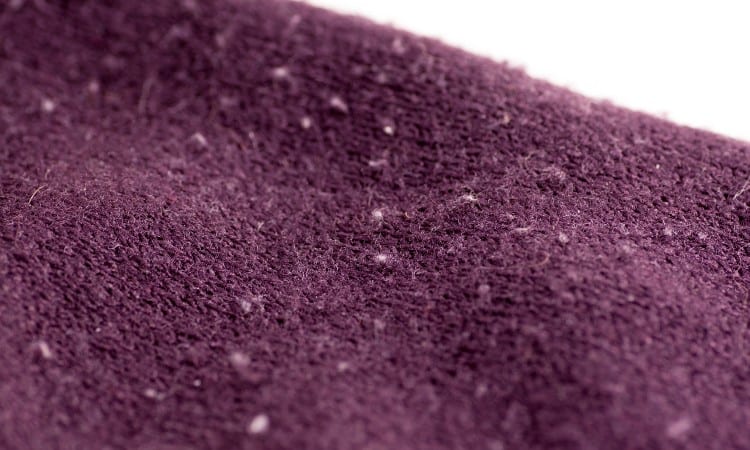
Quick Navigation
What is Lint?
Lint is made of tiny bits of fabric fibers that stick to the clothing surface because of static cling. These flakes of fabric fibers come from all over the place but primarily from your clothing itself.
This happens because many popular clothing fabric types contain short fibers twisted together into yarns. Over time, friction and general wear and tear cause the yarns to rub together, which in turn causes some of the fibers to snap free and float away.
Cotton, wool, and linen can create a lot of lint because these fabric types often have short fibers inside each thread. But synthetic fabrics like polyester also create a decent amount of lint, especially after going through multiple washes.
Why do your clothes attract lint? The reason these tiny fragments of fluff do not just float away into the air is static cling. You can think of static cling as the tendency for lint, dust, and other small particles to adhere to clothing because of static electricity.
When your clothes rub together or rub onto other fabric surfaces like a couch, a small electrostatic charge builds up. This then causes the opposing forces of the positive and negative charge on your clothing and the lint particles to snap together like two magnets attracting each other. A constant low level of this electrostatic charge causes lint to continuously adhere to most clothing.
What Causes Lint on Clothes After Washing and Drying?
One of the biggest causes of lint accumulation on clothes is the normal washing and drying process.
Even if you use a gentle wash setting, your washing machine uses friction to clean clothes.
As the drum turns, the clothes jostle around and rub against each other. This helps clean clothing by loosening dirt or other stains and allowing any grime to float away into the water. But the constant friction also causes loose fibers in the clothing to separate and break away, creating lots of lint.
The dryer creates additional friction as the clothing tumbles through the heated cycles. But actually, one of the biggest reasons clothing holds onto lint is all the static electricity caused by the dryer.
Have you ever taken your clothes out of the dryer and found several garments stuck together? You may even have to pull hard to separate them! This happens because of an extreme buildup of static cling. Synthetic clothes made of polyester and nylon have an especially bad tendency toward static cling.
Static cling is what makes fuzz stick to clothes. Almost all fabrics maintain a certain level of static cling, though you can use special products like antistatic spray to alleviate this problem.
Not all lint comes from the washer and dryer, of course–over time, the inherent static cling in your clothing will attract a certain amount of dust, skin cells, and bits of fuzz from the air, the furniture you sit on, or other people you pass by. But it is true that most of the fuzz you find on your clothes comes from your own laundering processes!
You can take a few simple precautions to remedy some of the lint created by washing and dryer clothes, as you will see later in this article.
And of course, you can also pick any of these twelve simple methods to remove lint from your clothes!
How to Remove Lint From Clothes: 12 Methods
You can quickly remove lint from your clothes using common household products like tape, dryer sheets, a hairdryer, a kitchen scrubber, or even a cupful of vinegar. You can also use products designed to remove lint, such as a lint roller or antistatic spray.
1. Lint Roller
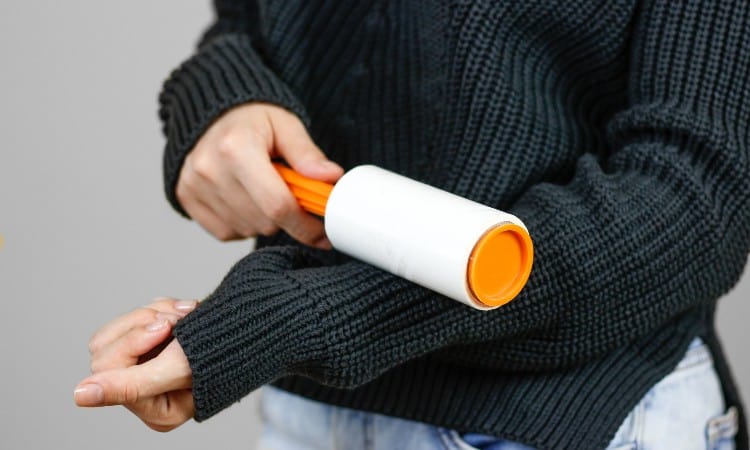
The most obvious solution for a lint problem is to use a lint roller. You can find these for sale in the laundry section of most grocery or big box stores, or even more cheaply at your local dollar store! It’s a great idea to keep one in the glove compartment of your car to have on hand before you go to an important work meeting or date.
Lint rollers typically come in two different styles. Most modern rollers are rolls of sticky paper. As you roll the stickiness over your clothes, it peels away any loose bits of dust or fluff. You then rip off the top sheet of paper from the roll and discard it, leaving a fresh, sticky layer on the roller.
Older and more expensive types of lint rollers have a felted surface that brushes over the cloth and use a stronger level of static cling to cause loose fuzz to stick to the felt rather than your clothes. But the sticky kind is much more common these days, so that is what you will find in most stores.
To use a sticky lint roller:
- Remove the outer wrap on the roller. Typically, this is the paper packaging it comes in. Set this aside and save it so you can wrap the roller back up to keep it from drying.
- Spread out your clothing on a flat surface. In a pinch, you can use the roller while wearing your clothing, making it hard to reach all areas of the garment.
- Hold the roller parallel to the garment. Then roll it down the garment from the top toward the bottom in a slow sweeping motion. Don’t press down too hard, as you want the roller to roll across the fabric as you move your hand.
- You should see lots of fuzz sticking to the roller.
- Repeat this motion until you have rolled over the whole garment and you no longer see visible lint on the surface of the fabric.
If you don’t want to spend money on a lint roller, you can make a temporary roller yourself. Simply wrap a length of packing tape sticky-side out around the cylindrical section of a rolling pin. Then use the rolling pin the same way as a roller to peel fuzz off your clothes!
2. Tape
Any kind of tape like office, masking, or even duct tape can effectively remove lint from clothing. This process does not work as quickly on a whole garment as using a lint roller, but it works perfectly on a small clump of fuzz. Plus, you can easily find tape even if you’re away from home, making this a perfect solution for the workplace!
To use tape to remove lint from clothes:
- Cut a four or five-inch length of tape.
- Make the tape into a loop around two of your fingers by attaching the two ends or the tape to each other, with the sticky side of the tape facing out around the loop.
- Press one side of the looped tape to the garment and then lift it. You should see the lint sticking to the tape.
- Repeat this motion anywhere you see the fuzz on the garment. You may need to make a new loop of tape as the first piece of the tape becomes covered in lint.
3. Dryer Sheet
 Dryer sheets can partially eliminate static cling, making them an excellent choice to get rid of lint on clothes. You can also put dryer sheets to their traditional use of going in the dryer, which helps prevent lint accumulation in the first place. But for this technique, you will use the sheet to wipe down a garment with fuzz.
Dryer sheets can partially eliminate static cling, making them an excellent choice to get rid of lint on clothes. You can also put dryer sheets to their traditional use of going in the dryer, which helps prevent lint accumulation in the first place. But for this technique, you will use the sheet to wipe down a garment with fuzz.
- Get a fresh dryer sheet that has not gone through the dryer yet.
- Spread out your clothing on a flat surface.
- Wipe the sheet across the fabric. Keep wiping in the same direction, so you do not drag fuzz back into a cleaned area.
- When you finish, discard the dryer sheet. You will have taken the lint off your clothes and made them less staticky so that it will take longer for new lint to accumulate!
4. Vinegar
 If you have a little time to get lint off your clothes, you can use vinegar in your washing machine to treat a whole load of laundry at once. You can also consistently use this as a preventative measure if you want!
If you have a little time to get lint off your clothes, you can use vinegar in your washing machine to treat a whole load of laundry at once. You can also consistently use this as a preventative measure if you want!
Using vinegar works well to remove a lot of lint from many clothes in one go. It may not as effectively remove every speck from a particular garment as a lint roller.
If you have the option to add liquids to your machine on a time-release, pour ¼ cup of distilled white vinegar into the chute before you start your load. If you do not, pause the machine before its last rinse, pour the vinegar into the basin, and then start it again.
Vinegar will help remove lint from the laundry as it finishes rinsing.
5. Kitchen Scouring Pad
If you need to scrape lint off your clothing quickly, you can try using a steel or copper wool kitchen scouring pad. There is no magic chemical interaction between the scouring pad and the lint in this method. The scrubber quite simply scrapes the fuzz off the surface of the fabric.
You would not want to use this method on super delicate fabric, but it will do just fine on your slacks or blazer in a pinch!
- Use a scouring pad fresh out of the box. Even if the one in your sink looks clean, it may have grease or other foodstuffs embedded in it.
- Hold the pad under running water and then squeeze it so that it is not dripping.
- Smooth out your garment on a flat surface.
- Lightly scrape the scouring pad over the garment. Try to work in the direction of the grain of the fabric if possible. Also, make sure you keep scraping in the same direction.
- You will see a little pile of fluff accumulation. Use your fingers to pinch this off as you, as the scouring pad will not collect all of it.
6. Hairdryer
For super-speedy lint removal, try using any wiping or scraping method and a hairdryer set to a cool temperature.
- To do this, start by picking a scraping or wiping method. For this, you can use the dryer sheet, scouring pad, or razor method effectively.
- Set your garment as flat as possible in front of you.
- As you wipe or scrape your implement along the surface of the fabric, aim the hairdryer to blow cool air behind the implement. This will carry away the loose lint you scrape off!
7. In Washer
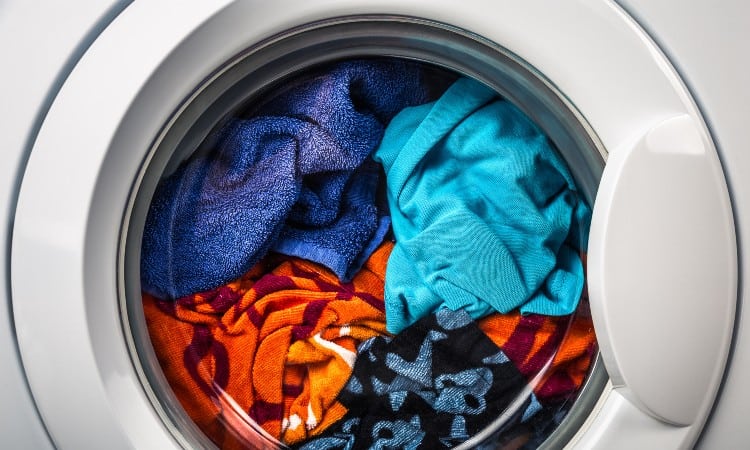
One of the best ways to protect your clothes from lint during laundering is to turn each garment inside out before putting it in the washing machine. This way, any fuzz floating around in the water will stick to the inside of the garment instead of the outside!
Washing your clothes inside out comes with all kinds of benefits. Turning clothes inside out will protect any vinyl or embroidered designs on garments. It helps prevent snagging from zippers or snaps. It also decreases pilling on the surface of a fabric, prolonging the life of a garment.
So basically, you should turn your clothes inside out before washing, even if you don’t care about the lint accumulation!
Can you wash lint out of clothes? If you have a lint-covered garment, try running it through a cold water cycle in the washing machine, and add ¼ cup of white vinegar right before the final rinse. This may not remove all the fuzz, but it will take it down to manageable levels that you can handle with another method.
You can also try adding fabric softener to your washing machine. This helps prevent lint buildup because it cuts down on static cling significantly.
8. In Dryer
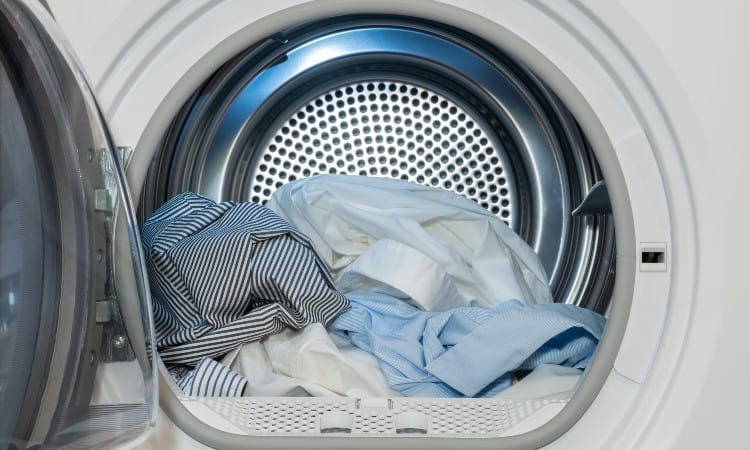
It’s true that your dryer is often the main cause of lint on clothes, but you can also use it to remove the annoying fluff if you know what you’re doing!
If you have a dryer with an “air fluff” setting, make sure you select this as you place damp clothes into the drum. This setting uses no heat and instead tumbles the clothes with cool air. This will help prevent the buildup of static electricity and should help eliminate lint.
If you do not have this setting on your dryer, try placing a fresh dryer sheet with your damp clothes. This will also help prevent static electricity, though it will not entirely eliminate lint.
Finally, make sure you clean out the filter in your dryer before every load of laundry.
9. With Razor
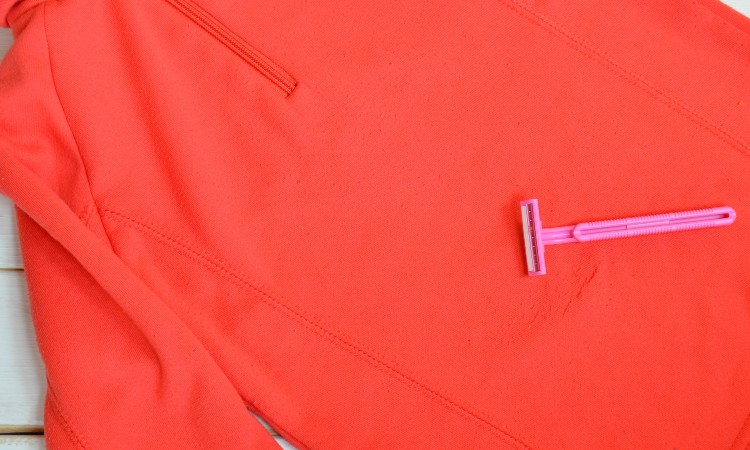
Another quick way to get lint off certain types of clothes is to use a disposable razor. You can also use this technique to get pills or fabric knubs off your clothes, but make sure you do not try this method on shiny, silky, or velvety fabrics.
- Spread out the clothing on a flat, hard surface, like a table.
- Place the blade of the razor near the top of the garment, such as at the collar or the top of a sleeve.
- Lightly draw the razor down with the grain of the fabric. Don’t press down too hard or you could damage the material.
- Repeat this motion until you have lightly scraped all of the fuzz off the whole garment.
10. Without Roller or Tape
If you do not have a lint roller or a piece of tape handy, you can try using the prickly side of a piece of velcro to collect fuzz off your clothes.
This is fantastic save in an emergency where you discover lint on your clothes and have anything from a sneaker with velcro to a winter coat with velcro at hand!
- Ideally, use a piece of cut velcro rather than velcro already sewn into your clothes. But if all you have is your winter coat, use the section of velcro with loops rather than hooks (the side that feels prickly instead of fuzzy).
- Scrape the velcro lightly over the lint-covered area in your clothes. It may push the fuzz into a neat line, which you can collect with your fingers.
- Repeat this on any other lint areas on the garment.
11. Handwashing
One of the best ways to keep lint off your clothes is to handwash delicate or expensive garments. You may also want to use this method if you want fuzz-free clothes for an important event like a graduation or interview.
Of course, handwashing clothes one garment at a time does take considerably longer than using a washing machine. But if you want lint-free clothes, you may find this method worth the extra effort.
- Fill a clean bucket with about two gallons of cool water.
- Measure in one to two teaspoons of regular laundry detergent.
- Swish your clothes one item at a time in soapy water. Let the garment soak for five to ten minutes.
- Lift it out of the water and gently press out as much water as possible over the bucket.
- Refill the bucket with clean water and swish the garment against it to remove the soap.
- Roll up the damp garment inside a clean bath towel to take out some of the water.
- Finally, hang it up to air dry.
12. Commercial Products
 One final trick you can use to keep lint off your clothes is to use a commercial product like an antistatic spray. Antistatic sprays work because they contain a polymer as a conductor and a solvent that evaporates. The evaporated solvent leaves the polymer as a thin coating that effectively prevents static buildup on the fabric.
One final trick you can use to keep lint off your clothes is to use a commercial product like an antistatic spray. Antistatic sprays work because they contain a polymer as a conductor and a solvent that evaporates. The evaporated solvent leaves the polymer as a thin coating that effectively prevents static buildup on the fabric.
Most antistatic sprays do contain chemicals that could prove harmful through extended exposure. If you find this alarming, you can also make your own spray by mixing one cup of water with two tablespoons of fabric softener in a spray bottle.
One bonus to trying this method is that it will also help prevent your clothes from sticking to you as you walk! If you have ever had a dress cling to your legs as you walk, you know just how annoying static electricity can be!
How To Get Stubborn Lint Off Clothes
The best methods to get stubborn lint off clothes are the lint roller method and the razor method. You can safely use a lint roller on most garments, even on delicate fabrics like wool or silk. You should not use the razor method on delicate or shiny fabrics, as it could scrape await the surface fibers on these materials.
The dryer sheet method also works great and has the added benefit of helping prevent static buildup for a little while. You may want to keep a dryer sheet in your car or purse to swipe over your clothes before an important event.
What Can Dissolve Lint?
It doesn’t exactly “dissolve” lint, but vinegar will rinse fuzz away from clothes pretty effectively. You can soak lint-covered clothes in a basin filled with a couple of gallons of water and a cup of white vinegar, or simply add a quarter cup of vinegar to the rinse portion of your washing machine cycle.
Most of the time, though, especially if you’re in a hurry, you will find it more effective to peel or scrape lint off your clothes.
How to Prevent Lint on Clothes
The best way to handle lint on your clothes is to prevent it from sticking in the first place! You can take several preventative steps to help keep your clothing lint-free.
- First, clean out the lint collector in your dryer every time you use the dryer. You should also look into getting a professional to clean the outdoor vent of the dryer once a year.
- Check the pockets in your clothes and the muff in your hoodies before they go into the washer. How often have you missed a tissue tucked into a pocket and found white fuzz all over a whole load of laundry?
- Turn all f the clothes inside out before you wash them.
- Do what you can to prevent static buildup. Add fabric softener to the washer, dryer sheets to the dryer, and consider applying antistatic spray after the clothes dry.
- Finally, if you have a fancier dryer, try using the “air fluff” setting instead of a heated dry.
How to Get Rid of Lint on Black Clothes in Washing Machine
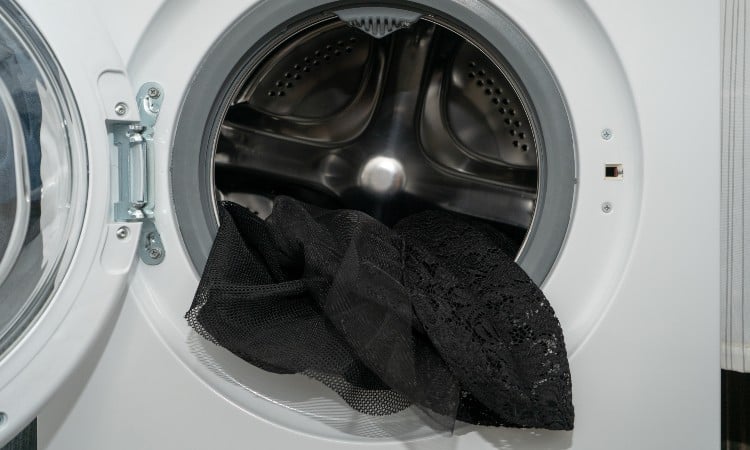
The best way to get lint off black clothes in the washing machine is to use the vinegar method or to add fabric softener to your washing machine. Don’t use these two products together, though, as the vinegar will rinse away the fabric softener.
You should also get in the habit of turning black clothes inside out before washing them, as this will prevent most of the lint buildup on the outside of the garments.
Honestly, though, there is no perfect way to prevent fuzz from sticking to clothes in the washing machine. Even if you use all these precautionary measures, you will probably see flecks of lint on your black clothes. You may want to keep a lint roller near your washing machine and dryer to use on black clothes as they come out of the laundry.
Best Way to Remove Lint From Clothes
The best way to remove lint from clothes quickly and completely is to use either a lint roller or a dryer sheet. You can also effectively remove lint using various scraping tools like a razor or a kitchen scrubber. To remove lint in your washer and dryer, try adding vinegar to your washer and using an “air fluff” setting in your dryer.
Commercial products can help prevent lint from sticking to your clothes by lowering the static charge on the surface of the fabric. These include fabric softeners and antistatic sprays. You can also use simple preventative measures like turning your clothes inside out to help prevent lint buildup.
Have you ever experienced a bad lint buildup on your clothing? What is your favorite technique for removing lint? Leave a comment below to let us know!